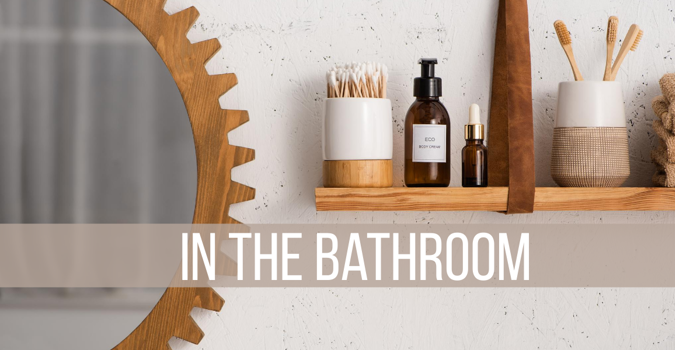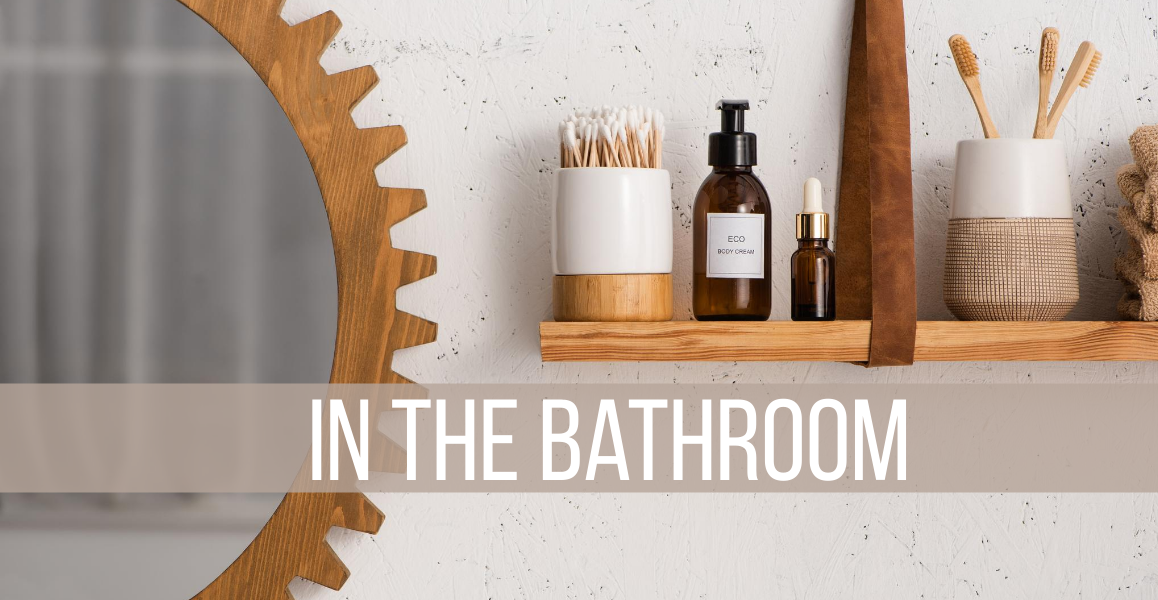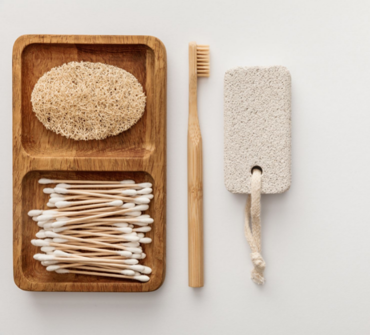How to reduce waste at home
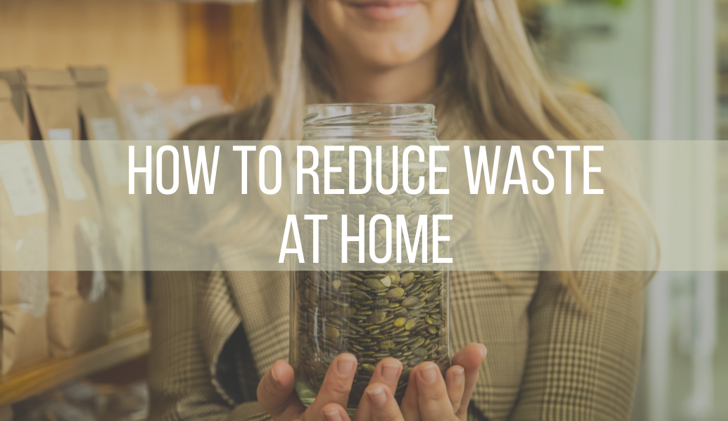
Embracing a zero waste lifestyle at home is a powerful step towards minimizing our impact on the environment. It involves making conscious choices to reduce, reuse, and recycle in every aspect of our daily lives.
By practicing mindful consumption, such as buying in bulk, using reusable containers, and opting for package-free products, we can significantly reduce the amount of waste generated in our homes. Implementing composting systems and prioritizing the purchase of second-hand items further diverts waste from landfills.
Through simple actions like conserving energy, water, and resources, as well as embracing eco-friendly cleaning and personal care products, we can create a sustainable haven within our own four walls, setting an inspiring example for a greener and more sustainable future.
In the Kitchen
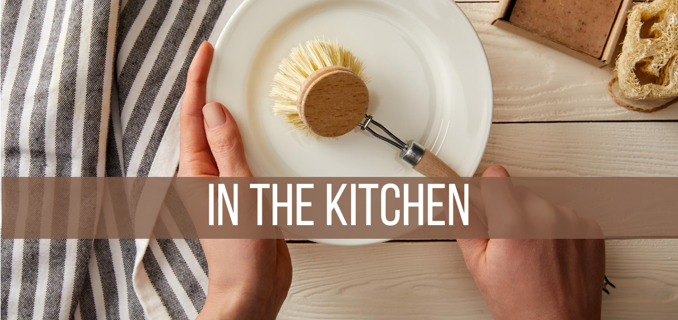
Here are some handy tips and ideas to start you on your Zero Waste journey in the kitchen.
Write a meal plan and shop to a list
Taking the time to write a simple meal plan and shopping list can not only prevent food wastage but also save you money.
Follow these basic steps to creating an easy meal plan (cred Living Richly on a Budget - 20 Meal Planning Ideas for Beginners (livingrichlyonabudget.com):
1. Create a meal planning routine eg. Friday night plan meals, Saturday morning - go grocery shopping.
2. Focus on planning weeknight dinners first - that's just 5 meals.
3. Check your calendar for the next week - make a note of the nights you don't have to cook.
4. Write a menu for each night you have to cook.
5. Check your fridge and pantry for ingredients that need to be used up and plan meals with this food.
6. Write your shopping list based on your menu - make sure you include pantry staples if you need them.
7. Lastly, the golden rule - don't go grocery shopping on an empty stomach! Have a healthy snack before you go :)
Food Storage
Plan to bulk buy goods that you can store in containers at home. Shop at bulk goods stores like Bin Inn or Down to Earth, take your containers and fill them directly.
Buy a set of attractive storage containers (preferably glass) and label them - check out YouTube for some label making inspiration.
When storing food in the fridge, swap cling film or zip lock bags for reusable silicon food covers that create a spill-free air tight seal. Instead of cling film invest in some bees wax wraps.
Transfer leftovers into reuseable containers you get when having takeaways, or systema with lids.
Quick tip: screw-top glass jars are a fast solution when you have left-over canned food, stock or gravy.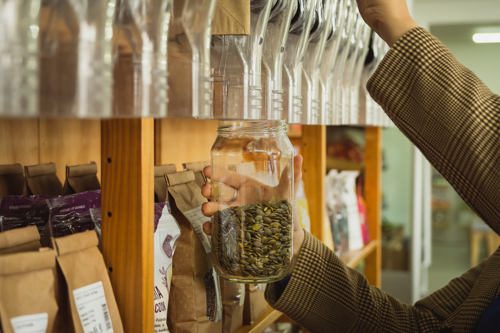
Start a Kitchen Garden
Grow your own fruit and vegies! If you only have a small space for growing, consider planting potatoes, lettuce or herbs in pots or buckets. If you have a large space, do some research on your favourites and get planting.
Feed your kitchen garden with compost made from your household food scraps and green waste or start a worm farm. Composting stops all that kitchen waste going to landfill and provides your soil with nutrients.
Avoid supermarket plastics
Buy meat at a butcher to avoid plastic/polystyrene trays and plastic wrap. Ask them about waste-free options, bringing your own containers or if they can wrap your meat in paper rather than plastic for the trip home.
Bake your own treats and lunch box goodies like crackers, biscuits and slices.
Bake your own bread, buy from a local bakery or order fresh-made bread from online providers like PureBread.co.nz. When ordering make sure you choose the paper wrap option.
Buy milk in glass bottles from suppliers like Beach Road Milk in Omata or Dolly’s Milk in Stratford. This is raw milk that comes from a dispenser into a bottle or container you provide.
If you are dairy free, make your own oat or cashew milk or purchase your almond/soymilk in recyclable bottles instead of the lined carton option. If you have to purchase alternative milk in a carton, these can be taken to The Junction on Colson Road for recycling. Please cut open and wash first, any plastic tops or caps can remain on the carton.
Quick tip: use paper bags from shopping as a plastic free alternative to store potatoes, kumara or onions.
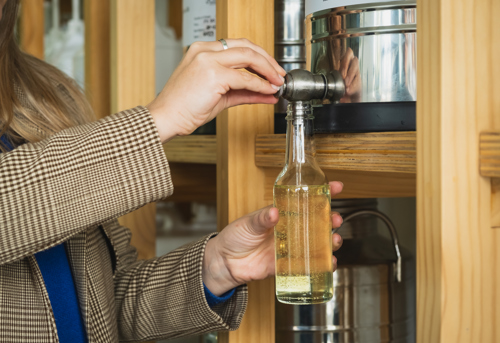
Pack a lunch for work or school
Eliminate cling film by using a flat clip-lock container for sandwiches, bees wax wraps or reusable snack bags made of funky fabric and closed by Velcro or zips.
Take fruit, it has its own natural packaging :)
Buy yoghurt in the large pottles and divide into small reusable containers for snack sized portions.
Make your own yoghurt with a kit from the supermarket. Prep takes five minutes and then leave 8-12 hours (or overnight). Put the finished yoghurt in a water-tight container and decant into smaller pottles for your lunch or snack.
Bake muesli bars, muffins or slices and put them in a reusable snack bag or container.
Avoid single-use portion packets like snack packs of chips and crackers, buy larger quantities instead and divide up for the kids into small resealable reusable bags.
Quick tip: cutting fruit the night before and storing portions in a glass jar with a dollop of yoghurt or mascarpone is a delicious snack in your busy day – and it looks café-ready!
Avoid altogether
The more we do something the more new habits will set in. Here is a list of things to avoid buying altogether or try to replace with eco-friendly options:
- Cling film/plastic wrap - replace with bees wax wraps
- Paper towels - replace with fabric dishcloths
- Anti-bacterial wipes - replace with bottled disinfectant and cloth
- Small single-use packets - replace with bulk items or make your own
- Plastic bin liners - eliminate use or replace with paper bags
- Plastic soap bottles - replace with soap bar
Doing the Dishes
Swap your plastic dish brush for a compostable wood and vegetable fibre bristle eco-brush, some even have a replaceable head. Get these online or from This + That.
Put dishwashing liquid in a glass bottle with pump, and refill at stores like Bin Inn or Down to Earth, make your own (link to recipe below) or use a dishwash soap bar.
Go for cotton dishcloths and tea towels, absorbent and reusable.
Bin separation
Divert waste from the landfill by having separate smaller bins in the kitchen, that you can then transfer to the correct kerbside bin. This makes it easy for your household to separate their waste on the spot.
When you’re rinsing and separating your recycling and putting your organics in the compost, you shouldn’t have much left to go in the landfill bin. Rinse your bin at the end of the week if you find it needs it.
Handy links for more great ideas to reduce waste in the kitchen
Pantry organising http://thesocialhome.blogspot.com/2012/02/pantry-pretty-dollar-store-pantry.html
Love Food Hate Waste https://lovefoodhatewaste.com/
Plastic-Free July https://www.plasticfreejuly.org/
Bread online https://www.purebread.co.nz/
Reusable snack packs https://www.lunchskins.com/collections/reusable
Bees wax wrap https://www.beeswrap.com/
Eco dish brush https://www.stevens.co.nz/search?q=dish+brush
Homemade dish soap https://www.mommypotamus.com/homemade-liquid-dish-soap-recipe/
Natural housekeeping tips https://www.thespruce.com/homemade-and-natural-cleaning-products-1900456
The Rubbish Trip Zero waste shopping guide Taranaki http://therubbishtrip.co.nz/regional-shopping-guide/zero-waste-in-taranaki/
In the Laundry
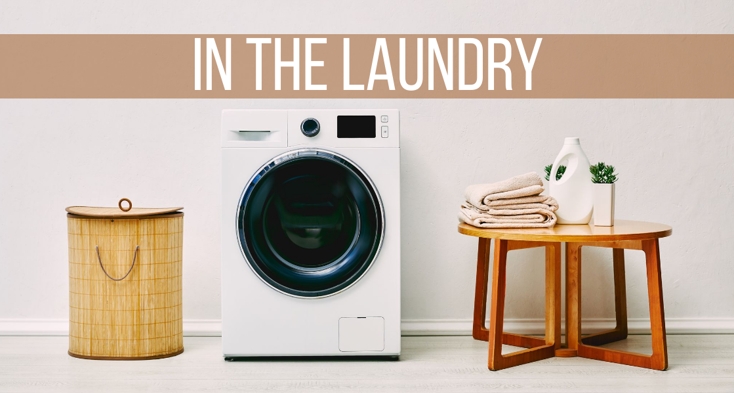 Level-Up your Laundry Game
Level-Up your Laundry Game
Beginner
Sustainable practices in the laundry start with some basics.
Use a cold wash
As simple as flicking a switch, changing your water temperature is the easiest eco-friendly change you can make. Ninety per cent of a washing machine’s power usage comes from heating the water! You save money, benefit the environment and prevent clothing dye from bleeding.
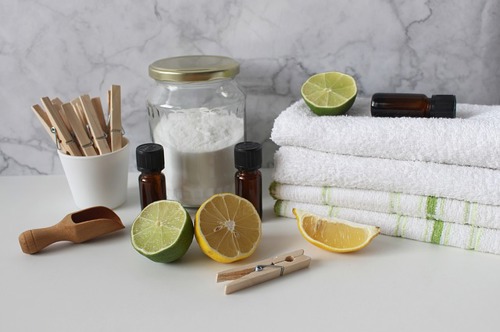
Do full loads
Keeping in mind your machine needs to have a tiny bit of room left to spin, try to cram in as much as you can with each load. The same amount of water and power is used per load. If you can reduce the number of times you use your machine each week, then you can save significant amounts of water and power.
Did you know...a full washing machine means less friction between clothing, a factor that is more important than you’d think. Friction during washing removes microfibers from clothing, leading to thinner, damaged clothes and oceans full of little microfibers.
Intermediate
Air dry
Use your clothesline as much as you can to protect your clothes and the environment. Dryers use power, a cost to you and they also reduce the life-span of your clothes. Shrinkage, colour fading and reduced fabric quality are all common results of heavy dryer usage.
Wash clothes inside-out
Save yourself the hassle of consistently replacing worn out clothing by washing clothes inside-out. This protects the outside fabric from fading and wearing, keeping your wardrobe newer for longer.
Advanced
Remove stains naturally
Make a paste of vinegar and baking soda to brush into fabric with an old toothbrush for an eco-friendly stain-fighting tool.
Stains caused by tomatoes, sugary products, coffee, wine, mustard, grease and yellow underarm perspirant will vanish when soaked in white vinegar for 10 minutes before washing. If the stain is still fresh, sprinkle on salt and baking soda before soaking in vinegar.
Use eco-friendly laundry soap
Our oceans will thank you for using brands made from natural and biodegradable ingredients. Products such as Earthwise, Ecostore and Eco Planet are found in all supermarkets and leave your laundry just as clean. Eco-friendly soaps may cost a bit more than other brands but if your keep your power and water usage to a minimum, you’re easily making your money back.
Use refillable laundry detergent
Take your own containers to places like down to Earth and The Junction and refill them with detergent and cleaning products, and you will be playing your part in reducing waste!
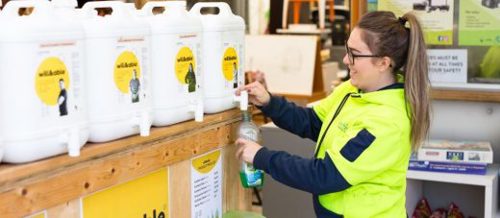
Master
Stainless steel clothing pegs
A little bit fancy, but a super saver over time! Plastic pegs break quickly under the harsh kiwi sun, ending up in landfills forever. Stainless steel pegs last a lifetime and are far more sustainable. Wooden pegs are a good choice too. They last longer than their plastic cousins and if they do break, they can be composted.
Soap nuts
Soap nuts are the berries of the Sapindus mukorossi tree of northern India and Nepal. Its shell contains lots of natural saponins (soap). Each load only needs three to six soap nuts, placed in a cotton-wash bag. They can be reused up to six times before heading to your composting bin. Being completely hypoallergenic, they are suitable for even the most sensitive skin. They work out cheaper than chemical detergents and help in the reduction of packaging to dispose of.
In the Bathroom
Hair
Switch to solid shampoo and conditioner bars. Check out the NZ made Ethique product range on the internet. To save on postage you could pop into Egmont Honey, Down to Earth, or Farmers to purchase these products. Some supermarkets now also stock these.
Shop at the Seaside Market for locally made soaps, solid shampoo bars and other beauty products.
Lush Cosmetics have stores across the world including Australia and New Zealand. Have a look at their unpackaged bathroom products.
Down to Earth in New Plymouth has a refill station where you can bring your own bottles and top up your shampoo and conditioner.
If you want to take it one step further and try the no shampoo route then try using baking soda and apple cider vinegar. You can find detailed instructions here.
Fight greasiness with cornstarch in place of dry shampoo, buying you an extra day before needing to wash again.
Try henna for a plant based low waste hair dye alternative.
Makeup
Make your own lip stain (with beet juice) or lip balm. Béa Johnson, author of The Zero Waste Home, has recipes for homemade mascara and eyeliner, which comes from a kohl powder she buys at the bulk store.
Support companies that offer closed-loop packaging production and who accept their containers for refill. Check out these plastic-free products on the Oh Natural website or have a scroll through what’s on offer at Etsy. Lush also offers some affordable ready-to-go products. Check out this blog for all the details.
Removing makeup
Replace facial wipes or cotton pads with a face flannel or muslin cloth and wash when needed. Buy a sponge, Konjac Facial Sponges are vegan and compostable after two to three months of use, or a fair-trade, sustainably grown sea sponge.
Instead of makeup remover, try using oil - olive, coconut or sweet almond. Oil does a surprisingly good job at cleaning the skin and is an excellent makeup remover for the sensitive areas around your eye.
Cleansing
Wash with a delicate soap like olive oil, oatmeal, lavender or goat’s milk that you can buy loose with no packaging. Check out the Seaside Market in New Plymouth for unpackaged soap and other facial products made using natural ingredients.
Exfoliate with the most basic ingredients that can be bought at bulk stores in reusable containers. Baking soda, sugar and coffee grounds all work well. Mix them with water or oil, and wipe off with a homemade washcloth.
Make your own masks using clays (French, bentonite or kaolin) bought in bulk online.
Check out Down to Earth for some great moisturisers in their health and beauty section.
Shaving
Try waxing or sugaring your legs, using squares of old clothes to pull it off.
Use a steel razor, these blades are known to last for up to ten years if you look after them.
Buy a bar of shaving soap (try to get a packaging free one) or try coconut oil.
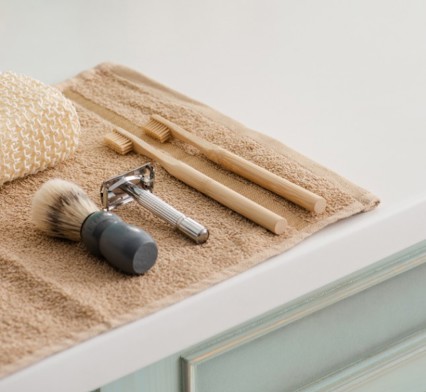
Nails
Use a metal clipper and nail file.
Moisturise the nail bed and cuticles with any oil or beeswax balm that you use elsewhere on your body.
Deodorant
Make your own deodorant. Amanda in Waste Free Land has all the tips on making DIY deodorant that you rub onto your skin with your fingertips. It is all natural with no nasty chemicals.
Perfume
Mix a few drops of essential oil with some sweet almond oil and rub it over your body after a morning shower.
Opt for a solid perfume bar from Lush or try to make your own perfume bar.
Toothpaste
Try making your own toothpaste! Here is a great DIY recipe.
Bamboo toothbrushes
Make the switch to a bamboo toothbrush which are readily available at your local supermarket.
Bathroom cleaning
Check out refillable options for bathroom cleaners. At the Junction you can bring your own containers and fill up on Will & Able bulk re-fillable products like eco-hand soap and eco-toilet cleaner.
Down to Earth also offers bulk refill of eco store products like bathroom cleaner.
In your Wardrobe
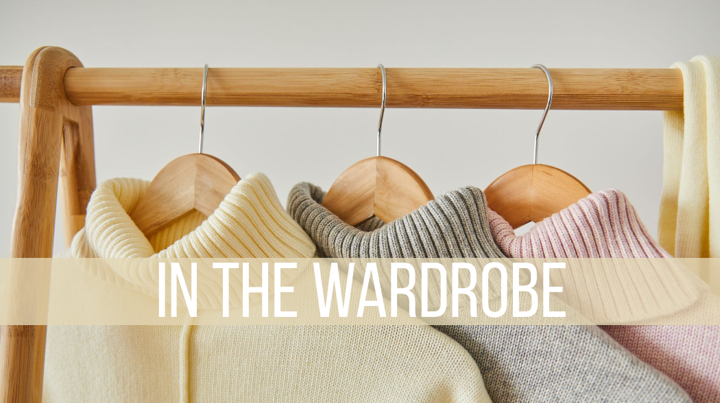
A zero waste wardrobe is a concept that embraces sustainability and mindful consumption in the realm of fashion.
It involves building a collection of clothing that minimizes waste and reduces our impact on the environment. Instead of constantly buying new items, a zero waste wardrobe focuses on reusing, repurposing, and recycling garments to extend their lifespan.
By embracing second-hand shopping, upcycling, and timeless designs, a zero waste wardrobe not only helps protect the planet but also creates a sense of personal style that transcends trends.
There are a number of ways to be waste conscious with your wardrobe.
Use a capsule wardrobe
A capsule wardrobe is a well curated collection of essential clothing items that can be mixed and matched to create a variety of outfits. It is a minimalist approach to fashion that focuses on quality, versatility, and longevity.


The concept behind a capsule wardrobe is to eliminate clutter and unnecessary choices, allowing individuals to streamline their style and simplify their daily dressing routine. By carefully selecting a limited number of high-quality pieces that align with personal style and suit various occasions, a capsule wardrobe reduces the need for constant shopping.
It prompts creativity in outfit combinations and encourages individuals to prioritize quality over quantity. With a capsule wardrobe, getting dressed becomes effortless and enjoyable, while minimizing waste and contributing to a more sustainable fashion industry.
Learn to sew, knit or crochet
Knitting, sewing, and crocheting are not just creative hobbies; they also play a significant role in promoting sustainability.
These crafts offer the opportunity to create your own garments and accessories, reducing your reliance on fast fashion and its detrimental environmental impact. By utilizing yarn and fabric from sustainable sources, or even repurposing materials from old clothing, knitters, sewers, and crocheters actively contribute to reducing waste and minimizing their carbon footprint.
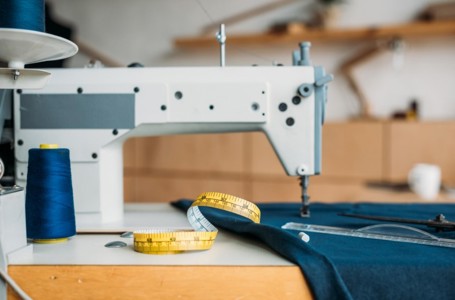
Hand-crafts foster a culture of slow fashion, emphasizing the value of handmade and well-crafted items. Rather than supporting the mass production of disposable clothing, hand-crafts encourage the creation of unique, durable pieces that can be cherished for years to come.
Learning these crafts will teach you how to repair and mend your clothing instead of discarding it. Whether it's patching up a worn-out sweater or altering a garment to fit better, these skills enable you to extend the lifespan of your clothing, reducing the need for constant replacements and saves you money.
Be second-hand savvy
Shop exclusively at second hand stores, vintage clothing shops or online through marketplace sites. Go to clothing swaps or walk-in-wardrobe events where you can pick up preloved clothing items while offloading items you no longer want to wear. Great for saving your pennies too! Remember to donate clean unwanted clothing to second hand or charity shops.
Be a clever shopper
Shop only a couple of times a year, avoid compulsive buys, and stick to your minimal wardrobe ethos. Be ruthless on fit, if the piece fits you well, you will be more likely to get the maximum amount of wear (and enjoyment) out of it. Spend money on classic pieces that will stay in style for a long time.
View our A-Z Zero Waste Directory
Find local options for donating, recycling and disposing your items safely and correctly.

